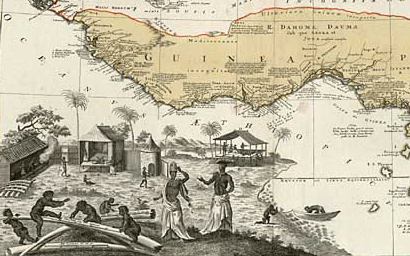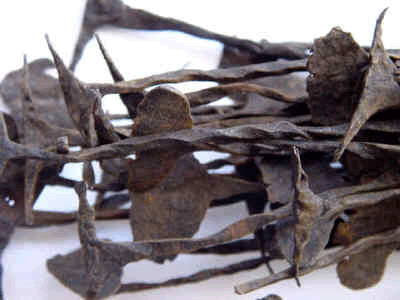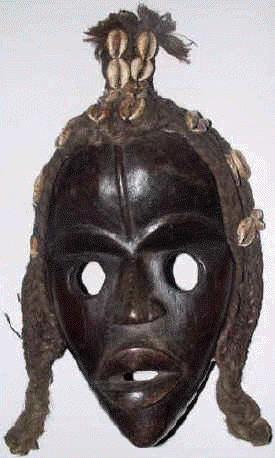|

The early inhabitants
According to the traditions of many African tribes their
ancestors were Pygmies, or persons of small size, and memories
of them still live on in numerous stories and legends. Although
no trace of their existence was ever discovered in West Africa
they are well-known to the peoples of this subregion. The
Sousou in what is now Guinea call them ‘Doki’, the Ouolofs in
Senegal call them ‘Kondrong’, the Malinke ‘Komo Koudoumi’
while in Liberia they are called ‘Jinna’.
The first inhabitants of the region which is now known as
Liberia may have been of small size too. No recorded history
can prove their existence, but they still play an important
role in the oral history and the religious life of some of
Liberia's tribes. When the Golas, who are supposed to be the
oldest of the Liberian tribes, travelled from the interior of
Central Africa to this West African region they reportedly met
these small-sized peoples, who were bushmen and who ‘dwelt in
caves and the hollows of large trees, and lived on fruits and
roots of wild trees’, according to Liberian historian Abayomi Karnga.
A second group of peoples is reported to have arrived in the
region about 6.000 B.C. Though their origin is not very clear
they most likely came from the Western Sudan. These newly
arrived people defeated the Golas and other tribes such as the
Kissi, and established an empire under the leadership of King
Kumba, after whom they were called. The Kumbas comprised
distinct groups which developed into different tribes after the
death of their leader; the Kpelle, the Loma, the Gbande, the
Mende, and the Mano, all belonging to the same linguistic
group. They were chiefly agriculturalists but also developed
arts such as pottery, weaving, and basket making. Their
blacksmiths were able to make spears, arrow-heads, hoes,
knives, rings and iron rods. These iron rods were used as a
medium of exchange.

Kissi money
The third group of peoples who arrived and settled in the
region which is now known as Liberia migrated to this part of
West Africa quite recently. They were the Kru, Bassa, Dei,
Mamba, and Grebo tribes. They came from what is now the
Republic of Ivory Coast. Population pressure - due to the mass
emigration of tribes from the Western Sudan where the mediaeval
empires had declined after their conquest by the Moroccan army -
had resulted in tribal wars. The Kru arrived in the early
sixteenth century. They came by sea, as did - later - a part of
the Grebo. Those Grebos who took the sea-route were later
called ‘seaside Grebos’ in order to distinguish them from
their kinsmen who decided to travel by land, the safer way.
Those who braved the dangerous waves still feel superior to
these so-called ‘bush-Grebos’. All the peoples of this
group belong to the same linguistic group.
The last group of tribes to arrive from ‘over land’ was the
Mandingo-group, comprising the Vai and the Mandingo tribes.
The Vai also migrated to the West African central region in
the 16th century and had probably the same motivation as
the tribes of the third group. They crossed the western part
of the actual republic of Liberia, clashed with the Gola whom
they subsequently defeated, and - later - moved to the coast
where they settled. The Vai form the first tribe of this
region which was moslem, unlike the tribes previously mentioned
which were all animists. It was one of the few tribes of Black
Africa who developed its
own script.
About the 17th century the Mandingos began to arrive in Liberia.
They were moslems too. They too originated from the Western
Sudan. They left this region after the Empire of Mali - of which
they formed a part - was considerably reduced by the Emperor
of Gao, Askia Mohammed, in the 16th century.
|
Introduction
It is generally believed that before 1822 there were 16 different tribes
living in what was called the ‘Pepper Coast’, ‘Grain Coast’ or
‘Malaguetta Coast’. One of them was exclusively living in what is
nowadays Liberia: the Bassa, the other 15 tribes were dispersed in the
region.
Presently they can also be found in neighbouring countries:
Guinea, Ivory Coast, Sierra Leone, sometimes even as far as the Sahel
country of Mali. E.g., in Guinea we also find: the Loma, Kpelle,
Mandingo, Mano, Gio, Ge, and the Kissi. In Sierra Leone: Mende, Gola,
Kissi, and Vai. Ivory Coast: Kru, Grebo, Bassa, Dei, and Krahn or Sapo (Teah
Wulah, ‘The Forgotten Liberia – History of Indigenous Tribes’, pp. 21 –
22).
Teah Wulah argues that there may be more tribes living in Liberia.
However, he notes, each tribe has more than ten sub-tribes or clans, and
their languages or dialects may vary to a small degree. He distinguishes
two language groups: Mande and Kru.
The Kru consist of Kru (Klao), Bassa,
De, Grebo, Krahn, Sapo and Niffu peoples. The Mande group comprises of
Mandingo, Vai, Kissi, Buzzi, Mende, Gbandi, Kpondo, and Kpwessi (Teah
Wulah, pp. 12 -13 and pp. 264 – 265).
Little is known about the number of people living in the coastal region
and the Hinterland in the 15th – 18th c. Estimates vary and historians
seem to disagree on the population density. Jones and Johnson write that
it seems unlikely that the coastal regions of what are now Liberia and
the Ivory Coast were ever densely populated, although the evidence on
this subject is slender (Adam Jones and Marion Johnson,
'Slaves from the Windward Coast, 1980)
Different spelling
Karnga (1926) uses the denominations Kpese for Kpelle, Mendi in stead of
Mende; Gbopoes, Gedeboes and Gruvos refer to the Grebos and Maa to the
Manos.
Roberts et al. mention (1972) the following alternatives: Malinke
(Mandingo), Gbande or Bandi (Gbandi), Kpessi or Kpwesi
(Kpelle], Dan (Gio), Ma or Mah (Mano), Kissi or Gissi (Kisi), De or Dey
(Dei) and Krou or Kruman (Kru).
Wulah (2005) elaborates on the following 16 Liberian tribes : Bassa,
Belle, Gbande, Gio, Gola, Grebo, Kissi, Kpelle, Krahn, Kru, Loma,
Mandingo, Mano, Mende, Sapo, Vai.
|
 |
|
Dan Mask |
|
The European Traders
Documents reveal that the first white men who landed on this
part of the West African coast were probably Hanno the
Cartaginian and his sailors, in the year 520 B.C. Hanno the
Cartaginian may have reached the coast near Cape Mount, where
he encountered the Golas. Trade started, but the contacts
between the two races were limited to only a few trade visits.
It was not until the 14th century that further and more frequent
contacts were established. About 1364 the Normans
settled (temporarily) at a few places on the coast of Liberia
and started trading with the coastal tribes from whom they
bought ivory, pepper, gold and camwood. The Portuguese also
frequented the Liberian coast as from this period and soon even
controlled the trade. In fact they had a monopoly for over a
century, before they were replaced by other European maritime
powers (France, England, Holland).
From the 15th century onwards the Portuguese, Spanish, Dutch,
English and French sailors and traders became common and
accepted visitors of the West African coast. Their influence on
the history of the area was considerable and their impact on
the lives of the peoples of the coast quite distinct. The
Portuguese e.g. named regions, mountains and rivers, and some
of these names are still in use. In the Liberian area the
Portuguese gave names such as (from west to east) Gallinhas
River, St. Paul's River, Mesurado River, St. John River, Cestos
River, Sanguin River and Cavalla River, and named the
promontories Cabo do Monte (at present Cape Mount), Cabo
Mesurado (Cape Mesurado) and Cabo das Palmas (Cape Palmas).
The coast between Sierra Leone and Ivory Coast was called
‘Malagueta Coast’ or ‘Pepper Coast’ after one of its main
products, the Malagueta pepper. The English and the Dutch
preferred the name ‘Grains of Paradise’, referring to the same
product. Later they abbreviated this name and it became the
‘Grain Coast’. The names of the coastal regions to the east of
Cape Palmas were also based on their main commercial products:
the Ivory Coast, the Gold Coast and (later) the Slave Coast.
The spices, gold and ivory, sought by the Europeans were
exchanged for textiles, alcoholic beverages, general
merchandise and, later, when this trade degenerated into the
barbarous slave trade, horses and weapons. The trade in slaves
soon ousted the more common trade and by the end of the
sixteenth century all European powers (of that period) were
engaged in this historical and inhumane commerce, an activity
that resulted in the diaspora of the Black race and the loss
for Africa of an estimated 20 million people. The damage for
Africa was even greater than the mere loss of a large number of
its population because the captured sons and daughters of its
soil were its most able and most productive workers. When the
slave trade was over Africa was left with hostilities between
tribes, with a disrupted social and family life and with famines.
The resulting weakness and dissensions greatly facilitated the
imposition of foreign rule.
Historical documents leave no doubt that the people of the
coastal area had reached an admirable standard of living. They
made many products which were of a higher quality than those
produced in pre-industrial Western European countries – as cited
by Sir Harry Johnston in his famous two volume work on Liberia
(1906):
"The traditions of the Norman traders who visited Liberia
in the fourteenth century and the authentic records of the
Portuguese commerce with that country before 1460 and 1560,
reveal a condition of civilisation and well-being amongst
the untutored natives which is somewhat in contrast to what
one finds in the same coast at the present day; still more
in contrast with the condition of the Liberian coast lines
in the early part of the nineteenth century, suggesting that
the rapacity of the Europeans, combined with the slave trade,
did much to brutalize and impoverish the coastal tribes of
Liberia during the two hundred years between 1670 and 1870.
They seem to have been well furnished with cattle, (in
Northern, perhaps not in Southern Liberia), with sheep,
goats and fowl, to have carried on a good deal of
agriculture, and not to have been such complete savages as
were the natives of the still little-known parts of
Portuguese Guinea, or the people of the Ivory Coast, who
were wild cannibals. (...) Having cast a glance at the
principal commercial products of these countries when they
were first discovered by Europeans, it may be interesting
to note the trade goods which Europe was able to offer to
the Blacks from the fourteenth to the seventeenth century.
To begin with a negative statement, there were no cotton
goods, no calicoes in the holds of these vessels such as
there would be nowadays. Strange to say, it was the natives
of the Gambia and other rivers of Northern Guinea, and
Cape Mount in Liberia that impressed the Europeans with
the excellence of their cotton fabrics, and actually sent
some cotton goods to Portugal. (…) It is possible that
no cotton goods were exported from Europe to West Africa
till the end of the seventeenth and the beginning of the
eighteenth centuries. Since that time the cotton goods of
Lancashire, of Germany, and of Barcelona have almost
killed the local industries of weaving and dyeing. (…)
As early as the time of Ca'da Mosto (middle of the
fifteenth century) cannon were taken on the ship and
gunpowder was fired to astonish and frighten the Negroes;
but there seems to have been no sale of gunpowder till
the close of the fifteenth century."
The Europeans were not only responsible for the naming of
places, the exchange of products, the introduction of fire-arms
and the carrying off of millions of Africans, but also for the
introduction and spreading of hitherto unknown diseases, such as
dysentery, syphilis and certain parasites.
In the region which is now called Liberia the (slave) trade thus
contributed to the impoverishment of and the hostilities between
tribes. Up till the present day the inter-tribal relations are
affected by the events of this period. The Golas, Krus, Kpelles
and Kissis were notorious slave traders conniving with unscrupulous
Europeans who looted the coastal areas. Besides this, the
northern tribes of the Mano and the Gio were feared because of
their cannibalism, a practice which was also not uncommon among
the Greboes and the Krus.
It was in this environment of slave trade, suspicion, fear and open
discord and hostilities that the first colonists arrived, aboard an
American ship, in 1820. They came from the U.S.A. where their
African ancestors had been sold to white masters. With the arrival
of these black and coloured people an experiment in ‘black colonialism’
started.
Also see:
A Dutch account of the Pepper Coast of the 17th century
From:
Fred van der Kraaij, ‘The Open Door Policy of Liberia – An Economic History of Modern
Liberia’
(Bremen, 1983, 2 volumes) pp.1 – 5.
Further reading / references:
Cassell, C. Abayomi, ‘Liberia: History of the First African Republic’
(New York, 1970).
Guanna, Jospeh Saye, ‘Liberian History Before 1857’ (New York, 1977).
Johnston, Sir Harry, 'Liberia', 2 vols. (New York, 1906).
Jones, Adam, ‘ From Slaves to Palm Kernels: A History of the Gallinas
Country, West Africa’ (Wiesbaden, 1983).
Jones, Adam, and Johnson, Marion, ‘Slaves from the Windward Coast’
(Journal of African History, 21 (1980), I, p. 17 – 34).
Karnga, Abayomi, ‘History of Liberia’ (Liverpool, 1926).
Kraaij, van der, Fred, ‘The Open Door Policy of Liberia - An Economic
History of Modern Liberia’, 2 volumes, 703 pp. (Bremen, 1983).
Moore, Bai T., ‘Liberian culture at a glance – a review of the culture
and customs of the different ethnic groups in the Republic of Liberia’
(Monrovia, 1979).
Niane, Djibril Tamsir, and Suret-Canale, J., ‘Histoire de l’Afrique
Occidentale’ (Conakry-|Paris, 1961).
Roberts, Thomas D., Kaplan, Irving, Lent, Barbara, Morrissey, Dennis M.,
Townsend, Charles M., Walpole, Neda Franges, ‘Area Handbook of Liberia’
(Washington D.C., 1972).
Siegmann, William C., ‘Rock of the Ancestors: namôa koni’, Liberian Art
and Culture from the Collections of the Africana Museum, Cuttington
University College (Suakoko, Liberia, 1977).
Rodney, Walter, ‘How Europe Underdeveloped Africa’ (Dar-es-Salaam, 1972;
London, 1973).
Wulah, Teah, ‘The Forgotten Liberia – History of Indigenous Tribes’
(Bloomington, 2005).
|
|


